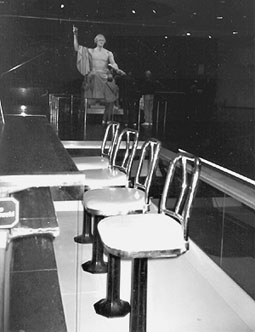 Woolworth lunch counter in Greensboro,
North Carolina, were not for everyone back then, at any price.
Woolworth lunch counter in Greensboro,
North Carolina, were not for everyone back then, at any price.Bay Reflection
What Price Freedom?
by M.L. Faunce
The cost of a banana split was 39 cents in 1960. A strawberry ice cream
shortcake just 29 cents. But the soda fountain treats listed on the signs
at the F.W.  Woolworth lunch counter in Greensboro,
North Carolina, were not for everyone back then, at any price.
Woolworth lunch counter in Greensboro,
North Carolina, were not for everyone back then, at any price.
Today, that lunch counter with four empty stools is on display in a busy hallway at the Smithsonian Museum of American History. Like a scene from a movie set, the luncheonette seems almost quaint now, but its starkness reminds of a darker time in our past.
On February 1, 1960, four African American students sat down to that now famous lunch counter in Greensboro, North Carolina, and politely asked for service. That they were refused service is for us, today, as anachronistic as a dime store itself. But racial inequality was pervasive in American life then. And throughout the south, a racist legal system known as "Jim Crow" separated people by race in restaurants, hotels, restrooms and most other "public accommodations."
After those four college students sat down at that F.W. Woolworth lunch counter in 1960, protests spread across cities in the South. The sit-ins led to a sustained youth-led movement that challenged injustice and racial inequality. After six months of protests, the lunch counter at Greensboro's Woolworth's was desegregated.
The luncheonette display at the Smithsonian seems to catch visitors by surprise. When I was there recently during a busy holiday period, families were scampering between exhibits of First Ladies' gowns, locomotives and musical instruments. Seeing the exhibit, some paused from their merriment and with quiet reverence drew closer to read the captions.
A young couple studied a chronology of the civil rights movement, a slow and uncertain journey if there ever was one. When I asked them what they thought of the lunch counter, they said they had read about it in school. Too young to have experienced the turbulent '60s, their interest seemed genuine.
I was a young woman just out of school and in my first job as a secretary in Washington when I discovered that when several of my co-workers went home to Norfolk, Virginia, they participated in sit-ins at shoe stores. Add that to the list of "public accommodations."
The F.W. Woolworth counter of the 1960s is on the second floor, Mall side of the American History Museum. It's flanked on one side by the original star spangled banner that was raised over Fort McHenry in 1814, and on the other by a once controversial sculpture of George Washington draped in a toga and seated on a throne. That they are all relics now, on exhibit at the Smithsonian, our so-called "nation's attic," says a lot about our country and our culture.
It also says a lot about the price of freedom and why we can't afford to forget what it cost.
-Contributor M.L. Faunce works on Capitol Hill in Washington and reflects from her home in Churchton.
| Back to Archives |
Volume VI Number 5
February 5-11, 1998
New Bay Times
| Homepage |